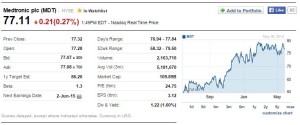
You hear all the time that this is a terrible time to be an investor. Maybe it’s after the fallout of some scandal, Enron and Worldcom from the early 2000s or Bernie Madoff from 2008 come to mind. Or maybe it’s that the market is evolving and people caught on the wrong side of that start to complain. A while back Michael Lewis published Flash Boys which looked at high frequency trading. One of the takeaways was that Wall Street giants were rigging the game to their advantage at the cost of smaller investors.

Of course, it wasn’t limited to Michael Lewis. We seem to be constantly barraged with stories about how investing is terrible now, the odds are stacked against the little guy, the fat cats are taking advantage of everyone.
I’m not an expert on high frequency trading or the million other death knells that people always point to when showing that the market is all screwed up. The eternal optimist, I actually think this is a great time to be an investor. Here are my top 5 reasons why we are in the golden age of investing.
5. Decimal stock prices: Today if you look up the price for a stock you get something normal looking like $40.63. However, before 2001, stock prices were quoted in fractions, so that same stock wouldn’t be $40.63, it would be 40⅝. First off, that was a royal pain the butt. Quick, which would cost more $20.30 or 20⅜? (20⅜ is more). We all remember fractions from elementary school, but they aren’t really intuitive in financial applications.
Secondly, it cost you real money. All stocks have a bid/ask spread which is the difference between what someone will sell something for and what they will buy it for. That difference is the profit that market makers get. As an investor you pay that spread, so the larger the spread the worse for you and the better for them. When stocks were in fractions, just the nature of fractions made the spread fairly large. So you might have an bid of 20⅜ and an ask of 20½. That’s a spread of 12.5 cents for every share you trade. That may not seem like a lot, but over hundreds or thousands of shares that starts to add up.
When stocks became decimalized, that 20⅜ became $20.38 and that 20½ became $20.50. But then competition among market makers squeezed the spread to something like $20.41 and $20.42. It’s not uncommon to see spreads of only a penny (see a recent quote I pulled up for Medtronic). That is real savings that goes into your pocket. In 2001 the SEC mandated all stocks be quoted in decimals and that was a real win-win: investing became computationally easier and less expensive.

4. Internet trading: You could have a whole post on how the internet has revolutionized personal finance (hmmmm, maybe I’ll do that). But here I’ll focus on internet trading and generally managing your investments online. When I started investing in the mid-1990s the main way you invested was by calling your broker and having her execute the trades you wanted.
Think about that for a second. You had to call someone, hope they answered, tell them what you wanted to do, and then have them do it. That just seems really inefficient. Later, some mutual fund companies got to the point where you could trade using your touch-tone phone (“press 1 to buy shares, press 2 to sell shares”), but even that was pretty kludgy.
Of course, once the internet came out, investing proved to be one of the ready-made applications for cyberspace. You could actually see your investments on a screen, in real time, push buttons to do what you wanted. Even set up things like automatic investments or withdraws. No question, it’s so much easier now than it was.
3. Low costs: With the internet and the incredible efficiency it brought, the costs of investing plummeted. Brokerage fees on some of my first trades were in the $50-75 range. That was with a full-service broker. Also there were ways that they nickel-and-dimed you with things like “odd lot hikeys” which was an extra charge if you bought less than 100 shares. Such a bunch of crap.
That was about the same time that “discount brokers” were becoming popular and started offering internet trades for $14.95. Once that genie got out of the bottle, there was no end to how low trades could go, and it made sense. All the stuff became automated, so the costs dwindled to almost nothing. Now you can find $4.95 trades and places like Vanguard offer $2 trades if you know where to look.
Think about that for a second. If you did 10 trades a year, in the old days (dang, that makes me sound old) that would have cost you $1500 per year (remember you get charged for buying and selling). Over an investing career, that $1500 each year could add up to almost a quarter of a million dollars!!! Maybe Michael Lewis will complain that investors are getting swindled out of a penny or two a share because of high-frequency traders, but that’s a drop in the bucket to what they’re saving by tiny, tiny trading costs.
2. Computing power: As reader Andrew H said in a comment, technology has advanced so rapidly that your iPhone has much, much more computing power than the Apollo 11 spacecraft. Computing technology has become amazing powerful and amazingly cheap in the past couple decades. A $300 laptop with Excel can allow you to do amazingly large and complex analyses that would have seemed magical just 30 years ago.
One of the huge applications for this analytic power is personal finance and better understanding the stock market. Many of my posts on this blog are just that—taking data and using Excel to make sense of stuff. Are you better of investing a windfall at once or over time? How often would you have lost money in the stock market historically? Those are fairly large analyses that would have been a massive undertaking 30 years ago, probably only possible at a major investing house or a university. Today, they’re done by a nerd with a cheap computer and too much time on his hands.
That computing power has been an amazing equalizer on the financial playing field. Now individual investors can figure things out for themselves instead of having to listen to brokers like they were priests from some secretive cult. That’s an enormous improvement.
1. Access to information: This is a biggie. The amount of information available to us now with the internet is mind-boggling. When I was a kid your source of information on stocks and investing was the evening news (“stocks were up 52 points today”) and the newspaper where you could look up the price of a stock from the previous day. That was it??? That was it!!!
Today you have real-time price quotes, you have real-time news, you have real-time analysis. You also have troves of data, and nearly all of it is free. All the analyses I have done is with free data on historic stock prices and inflation. That’s nice if you’re a dork like me, but how does this help normal people?
In investing, information is power, and we live in a time where that power is freely given to all. Let’s say you wanted to invest in Ford in 1990. How would you go about researching your investment decision? Maybe call Ford’s investor relations to have them mail you some annual reports, possibly go to the library to find some articles on the company, probably stored on microfiche. That’s crazy. Today you can find all that information plus about 1000 times more in less than 5 minutes on your computer. It truly is a completely different ballgame, and one that is very much to our advantage compared to what it had been.
Bonus reason—financial understanding: I couldn’t stop at five reasons, so I am including a sixth (the “Top 6” just doesn’t have the same ring). There has been tremendous research into financial markets and how they behave over the last couple decades. While markets are still very unpredictable by their nature, we understand them much better. Ideas like price-to-earnings ratio, index mutual funds, efficient markets, and a thousand others help us better understand how and why the stock market does what it does and that allows us to be better investors.
In a similar vein, the central bankers who guide our economy, and by extension the stock market, have learned a lot too. One of the theories on why the Great Depression was as bad as it was is because President Hoover and his advisors did all the wrong things. It’s not that they were vindictive and wanted to drive the country into a calamitous financial train wreck, but they just didn’t know what to do.
I absolutely believe the reason we haven’t had another Great Depression, including the Great Recession where we emerged largely unscathed, is because our central bankers are a lot smarter. Paul Volker, Alan Greenspan, Ben Bernanke, Janet Yellen, and now Jerome Powell all studied the Great Depression and other financial disasters and learned what those people did wrong and how similar fates can be avoided in the future. That understanding has saved us a lot of pain.
So there you have it. Sure, investing isn’t always a smooth path, and as Michael Lewis points out, there are always bad apples that are trying to screw things up. But with all that, don’t lose sight of the fact that investing today is soooooooo much better than it has ever been before.
What do you think? Are my glasses too rose-colored? Are there other awesome developments that deserved a place in the top 5?